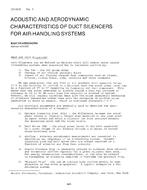
CH-81-06-1 — Acoustic and Aerodynamic Characteristics of Duct Silencers for Air-Handling Systems
- Comments Off on CH-81-06-1 — Acoustic and Aerodynamic Characteristics of Duct Silencers for Air-Handling Systems
- ASHRAE
This paper shows that silencer performance varies with silencer shape, configuration, face area, free area and length.
Duct Silencers can be defined as devices which will reduce noise inside airhandling systems when generated due to turbulent airflow by :
1) The fan – the air prime mover
2) Passage of air through straight ducts
3) Impact of air flowing through duct components such as elbows, brances, mixing boxes, rods, orifices and other elements.
We can generalize that any form of air movement will generate noise. If V is the velocity of airflow in a straight duct the sound power level may be a function of V5 to V7 depending on frequency and duct component. This means that the noise generated by airflow inside a duct may increase or decrease by 15 to 21 dB every time the velocity is doubled or halved. However, we will concern ourselves here with the noise generating mechanism of silencers themselves rather than with the mechanism of airflow noise generation in ducts in general, which is discussed elsewhere.
We will discuss two types of silencers: rectangular and round. The general configuration of the rectangular splitter silencer consists of a strong perforated steel envelope containing sound absorptive materials, that divides the air/gas flow into smaller sound attenuating passages. The rectangular silencer is used in rectangular ducts and in sometimes very large banks on the intakes and exhausts of fans.
Tubular or round silencers, at first sight are similar in cross-section to the rectangular ones, but consist of an outer cylindrical shell and an inner concentric bullet. The round silencer is often used in round duct systems in conjunction with vane-axial fans.
Citation: Symposium, ASHRAE Transactions, Volume 87, Part 1, Chicago, Illinois
Product Details
- Published:
- 1981
- Number of Pages:
- 22
- File Size:
- 1 file , 1.8 MB
- Product Code(s):
- D-CH-81-06-1

